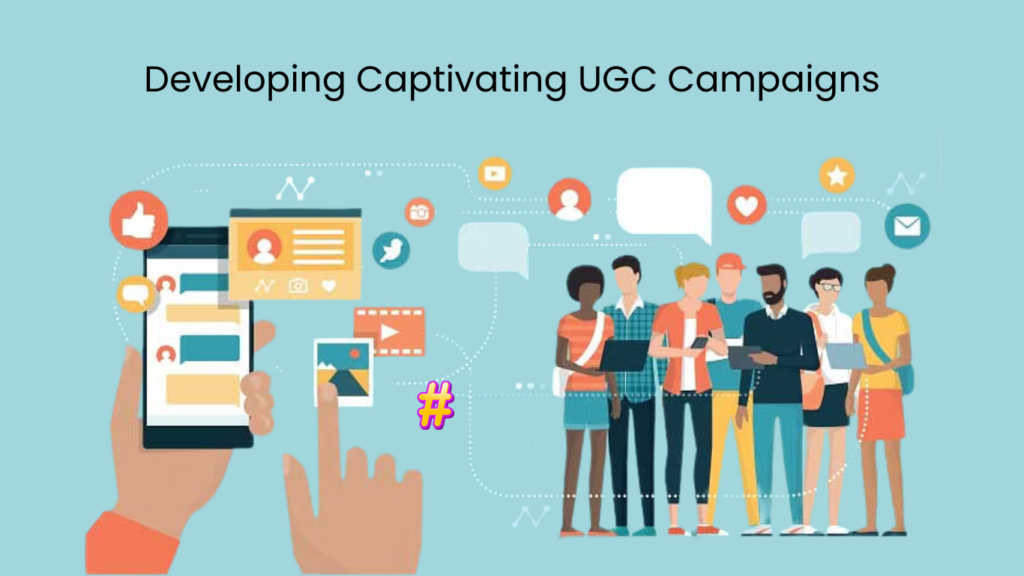User-generated content (UGC) has become a vital part of the modern marketing landscape. By tapping into UGC, brands can drive engagement, increase awareness, and improve return on investment (ROI). But maximizing the impact of UGC requires thoughtful strategies. This comprehensive article will explore how to develop UGC campaigns that attract authentic user content and help achieve business goals.
◼ What is User-Generated Content and Why Does it Matter?

UGC refers to any form of content that is created and shared by unpaid users of a brand or platform. This includes social media posts, reviews, testimonials, photos, videos, memes, GIFs, and more. UGC comes directly from a brand's customers and followers, so it carries an innate authenticity that makes it highly influential.
For brands, UGC offers numerous benefits:
- Increased brand awareness and reach: UGC expands reach as happy customers organically promote products and services they love. Their real-life usage and recommendations help introduce brands to new audiences.
- Enhanced customer engagement and connection: Consumers trust UGC 12x more than branded content because it provides unbiased perspectives from real users. UGC campaigns spur participation and foster brand affinity.
- Cost-effective marketing: UGC is created for free by users, providing highly cost-effective marketing. Brands don't need to invest in expensive photoshoots or video production.
- Drives conversions: 49% of social media users say UGC influences purchase decisions. The authenticity of real experiences cuts through sales hype and motivates purchases.
- SEO benefits: UGC helps boost page traffic and search rankings as users search for the brand, products, and user content.
The rise of digital platforms makes UGC highly visible and shareable. Implementing UGC strategies is crucial for brands seeking authenticity, engagement, and competitive edge. But a strategic, multi-pronged approach is required to fully leverage UGC.
◼ Creating an Impactful UGC Strategy

An effective UGC strategy sets the foundation for campaigns that inspire user participation while aligning with core business goals. Key elements include:
➤ Setting Objectives
Be clear about what you want to achieve. Common UGC goals include:
- Increase brand engagement and website traffic
- Gather visual content and testimonials to showcase products
- Promote new product launches or features
- Build social proof with ratings, reviews, and recommendations
- Create viral buzz and brand awareness
Having specific, measurable goals will allow you to track progress and ROI. Ensure teams are aligned on UGC objectives.
➤ Identifying Target Audiences
Determine which customer demographics and interest groups are most likely to contribute to impactful UGC. Prioritize audiences that engage frequently and share values with your brand. Ideal targets:
- Customers who frequently interact on social media
- Loyal brand advocates and ambassadors
- Influencers and industry experts
- Niche communities that align with brand values
➤ Selecting UGC Sources
Explore platforms and channels where your target users are most active. Monitor both brand-owned and third-party sources:
- Social media (Facebook, Instagram, TikTok, Twitter, LinkedIn)
- Visual content sites (YouTube, Vimeo, Pinterest, Flickr)
- Review sites (Yelp, Google My Business, App Store, Amazon)
- Community forums and discussion boards
- Blogs, websites, and niche media
- Ratings/recommendations on e-commerce platforms
- Hashtag tracking across sites
Identify where you can access authentic content from your audience. Expand beyond owned channels.
➤ Planning Content Curation
Outline processes for collecting and organizing UGC from selected sources. Useful tools include:
- Social media management platforms to aggregate content
- Google Alerts and Talkwalker alerts to track brand mentions
- Hashtag tracking tools like Keyhole and RiteTag
- Influencer marketing platforms to source creator content
- Aggregator tools like Feedly to follow niche sites
- Search engine queries and Google Trends
Automate where possible for efficiency. Schedule time to actively search for and save quality UGC.
➤ Moderating UGC
Have clear guidelines for screening and removing inappropriate, irrelevant, or misleading UGC. Balance moderation with the need to display unfiltered perspectives. Use disclaimers stating all opinions are user-generated—report policy violations.
◼ Developing Captivating UGC Campaigns

UGC campaigns encourage users to create and share branded content. Creative prompts and engagement incentives are key. Consider various formats:
➤ Social Contests
Photo, video, and art contests with a branded theme. Prizes drive participation while users generate visual assets.
➤ Hashtag Challenges
Leverage trending hashtags by inviting users to share brand-related posts. Expand reach and engagement.
➤ Testimonial Drives
Actively ask satisfied customers to share authentic reviews, stories, and recommendations. Highlight UGC through reposting.
➤ Ratings and Reviews
Promote calls to action asking users to leave ratings/reviews on sites like Yelp, Amazon, and other social platforms. Boost SEO and trust.
➤ User Polls and Quizzes
Interactive polls and quizzes inspire social sharing as users compare results and tag friends. Entertain along with info.
➤ Takeovers
Let an influential user temporarily "take over" your social media account to create UGC showcasing real experiences.
➤ AMAs
Host "Ask Me Anything" sessions for candid Q&As between users and brand representatives.
Choose formats that suit your goals, audiences, and channels. Diversify campaign types for sustained engagement. Have a content calendar to plan UGC initiatives.
➤ Creating Shareable Prompts
Well-crafted UGC prompts inspire great content.
- Offer clear, specific instructions. Include permissions needed.
- Link to brand values and personality for emotional appeal.
- Share sample submissions to spark ideas.
- Keep prompts short, visual, and scannable.
- Rotate themes and variations to stay fresh.
➤ Driving Participation
Encourage UGC creation through:
- Contests with prizes, votes, and leaderboards
- Exclusive perks and promotions for top contributors
- Co-creating content by involving users in planning
- Sharing and featuring select UGC across channels
- Email and ad promotions of campaigns
➤ Social Promotion
Market your UGC campaigns through:
- Paid ads and promoted posts
- Organic social posts from branded handles
- Influencer partnerships
- Website banners and on-site messaging
- QR codes
- Email newsletters
Multichannel amplification expands reach and sharing. Provide assets like images and sample posts to ease participation.
◼ Tracking UGC Metrics and ROI

Analyzing campaign data is crucial for optimizing efforts. Track:
➤ Volume Analysis
Measure UGC counts across sources:
- User posts/mentions
- UGC content submissions
- Reviews, ratings and recommendations
- Social engagement rate
Benchmark to identify content volume goals.
➤ Sentiment Analysis
Gauge user perceptions through:
- Sentiment analysis of terms used in UGC
- NPS or customer satisfaction scoring
- Topic and keyword tracking
Monitor for brand, product and issue mentions.
➤ Business Impact
Connect UGC efforts to key business metrics:
- Website traffic and conversions after UGC campaigns
- Sales trends following UGC initiatives
- New customer acquisition and lead generation
- Brand lift studies to quantify UGC impact
Continual testing reveals top-performing UGC sources, formats and campaigns. With accurate analytics, demonstrate UGC's value across marketing and sales funnels.
◼ Real-World UGC Campaign Examples
UGC drives impressive results. For example:
- Lululemon's #TheSweatLife campaign engages customers through user-generated sports photos and videos. The campaign has received over 735,000 hashtag uses and boosted brand engagement.
- Pet brand Chewy grew their Instagram following by 46% using their #ChewySquad campaign, which compiles pet photos from customers. The curated user content outperforms branded posts 3:1 for engagement.
- Airbnb created an online content hub featuring customer travel stories, photos and videos. Traffic to the storytelling hub converts at 4X higher than the Airbnb homepage.
- Protein bar brand RXBAR saw a 187% increase in reviews on their website after running a testimonial contest. The authentic customer stories helped increase the conversion rate.
◼ UGC Strategy: Key Takeaways
- UGC has unrivaled authenticity and drives measurable impact across metrics like awareness, engagement, and conversions.
- A thoughtful UGC strategy aligned with business goals is crucial for maximum impact. Elements include setting objectives, identifying audiences and sources, curating content, running creative campaigns, and tracking analytics.
- Compelling prompts, incentives and promotion expand UGC reach. Contests, takeovers, challenges, reviews, and more all engage users.
- Analyze UGC volume, sentiment, and business impact to continually refine strategies and demonstrate the value of user-generated content.
The most impactful brands find ways to meaningfully involve their community in co-creating stories and experiences. By implementing strategic UGC campaigns, you can leverage customer voices for marketing that resonates.
◼ Frequently Asked Questions
1. What is user-generated content (UGC)?
UGC refers to any form of content created and shared by unpaid users online, like social posts, reviews, images, videos, GIFs, memes, and more.
2. Why is UGC important for businesses?
UGC builds trust through real customer perspectives. It drives cost-effective engagement, conversions, and awareness by leveraging user advocates.
3. How can I create a successful UGC strategy?
Tips include setting goals, identifying target audiences and sources, planning curation and moderation, developing creative prompts/incentives, and tracking metrics to optimize efforts.
4. What are some examples of effective UGC campaigns?
Photo contests, branded challenges, takeovers, testimonial drives, interactive quizzes, reviews/ratings pushes, and crowdsourcing stories from customers have all proven effective for UGC.
5. How can I measure the ROI of UGC campaigns?
Analyze UGC volume, sentiment, conversions, traffic, sales, and brand lift across sources. Connect initiatives to business impact to quantify UGC ROI.
Read also: How To Raise Conversion Rate?
Conclusion
User-generated content represents the future of authentic, engaging marketing. By implementing UGC strategies that inspire advocacy and participation, brands can leverage their greatest asset - their community.
With compelling campaigns and smart analytics, UGC delivers measurable ROI across key metrics. Put processes in place to source high-quality content, involve your audience, and showcase real stories. Then let customer voices tell your brand's story.


